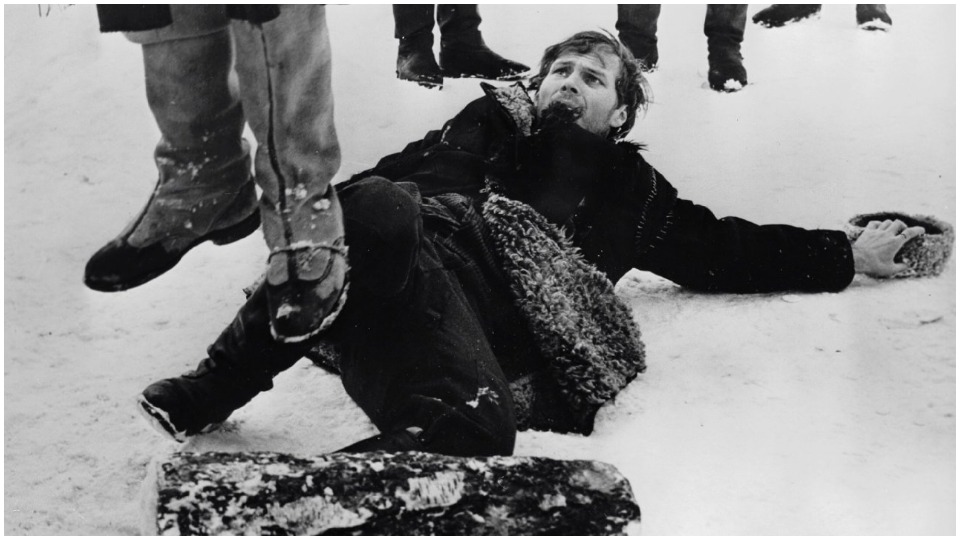
The Ascent is not the type of movie you would expect about World War II—or the Great Patriotic War, as it was known in the Soviet Union where the film was made.
First, a little background: The Soviet Union generally boosted the heroics of that war in popular culture whenever possible, and for good reason. Victory over Hitler was probably the most outstanding achievement of that socialist nation. The world owes the Soviet Union a debt of gratitude for its decisive role in the defeat of Nazi Germany, for which it paid an enormous price.
During the war, Belarus, known as Belorussia, was brutally invaded by Nazi Germany. An estimated 2,000,000 or more Belorussians died. The Nazis razed entire villages and slaughtered everyone in them. The monument of Khatyn, in present-day Belarus, marks a town destroyed by Nazis. The fascists locked 180 Soviet citizens in a church in March 1943, poured gasoline on the sanctuary, and set it on fire. They killed every man, woman, and child and machine-gunned down those who tried to escape.
The story of The Ascent goes like this: Two Soviet partisans in Belorussia, Sotnikov and Rybak, are sent out to find food for their group, which is down to no rations. After discovering a farm with its food destroyed, they turn to a nearby village. A Nazi collaborationist headman gives them a sheep, perhaps to get rid of them.
On the way back to their group, they are sniffed out by Nazis, who shoot Sotnikov in the leg. After initially leaving Sotnikov for dead, Rybak returns to him and seeks out help from a farm where a mother and her children live. The Nazis discover them and send the adults back to the village while leaving the children behind.
Upon arrival, Sotnikov is brutally tortured and then thrown into a dank basement while Rybak tells the Nazis what he thinks they want to hear. Rybak is offered a job with the police but hesitates to accept. Consequently, the Nazis imprison him with Sotnikov, the mother, and the collaborationist headman who helped the partisans. Basya Meyer, the teen daughter of a Jewish shoemaker falsely accused of housing partisans, soon joins them.
As Sotnikov lays in pain from the wounds of his torture, Rybak attempts to convince him to join the police and save his life. Sotnikov resists, saying, “But we are soldiers.” Rybak exclaims, “What are you but an empty corpse with your morals?” Sotnikov answers that Rybak can go ahead and live without morals if he wishes, as many do.
The next day they are marched to be hanged. Seeing his life will soon end, Rybak caves in. He takes the job as a policeman for the Nazis and agrees to assist in hanging Sotnikov. Cheerful martial music and the sight of nooses greet the accused as they approach the gallows.
The movie shows the deaths as a collective action, one born of both a forced necessity but also portrayed as a group of unfairly condemned human beings holding each other up the best they can. At times they even cooperate with their executioners in a calm, almost prayerful manner. Basya Meyer places the noose on herself after willfully standing on a stump soon to be kicked out from under her. There is no speech, no mournful supplication, but there is a silent cry from the mother. Before being executed, Sotnikov scans the horizon where he knows his comrades are hiding, safe for now from Nazi hands.
After the execution, the remorseful Rybak attempts to hang himself in an outhouse but fails. After exiting the outhouse, Rybak looks upon a world now closed to him, condemned to a lifetime of guilt and regret without hope.
The man executed was saved, the man who betrayed his comrades thrown into a form of eternal damnation. The parallels of this story are easy to ascertain.
When we think of wartime heroics, we usually think of a rousing speech made before an attack, a person storming a machine gun nest in a burst of glorious energy, or someone capturing hundreds of prisoners of war all on their own. Don’t expect that in this movie. This story is one of heroism born of pain, loneliness, and ultimately death. The film examines not only the human side of pain in duress but also the idea of morality in the face of evil, which is not only a decision to protect oneself but also a commitment to something beyond oneself. I term this a spiritual position. The characters who went to their death demonstrated their affinity to ideals more important than their lives.
Western powers would lead you to believe there was no room for the spiritual side of life in the Soviet Union. But Soviet films often showed the spiritual life of its people. Andrei Tarkovsky, perhaps the most morally contemplative of all Soviet directors, showed this often through characters like Andrei Rublev, a medieval painter of religious icons. The poetry-loving Soviets were deeply spiritual in ways that went beyond formal religious observance, and The Ascent is a quietly uplifting film. It garnered the Golden Bear at the 1977 Berlin Film Festival and is still considered by many as the finest Soviet film of its decade.
The Ascent was directed in 1974 by Larisa Shepitko and released in 1977. Shepitko was married at the time to Elem Klimov, who would later direct Come and See, a movie with a brutal and realistic portrayal of the Nazi campaign against the Belorussian people during that tragic war. This remarkable film was a portrayal of tragic historical events. The Ascent portrays the difficult decisions of individuals within those events. Come and See can be viewed as an emotional epic, and The Ascent a meditation on the transcendent values that affirm humanity in times of grave danger.
A relevant side point: In recognition of the enormity of sacrifice the people of the Belorussian Soviet Socialist Republic made in World War II, and also the Ukrainian SSR, both of these national entities, even though they formed part of the larger USSR, were admitted as separate member states of the United Nations.
The Ascent can be viewed from the Criterion Collection.
The Ascent
Directed by Larisa Shepitko
1974 (released 1977), Soviet Union












Comments